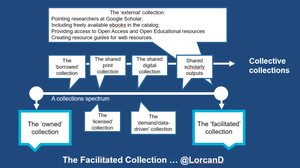I bought [i] a New York Times yesterday in our local Borders and, over coffee, was interested to open up a large two page spread advertising the newly named Thomson Reuters, A new name and a new logo.
I was interested to read the following in the business pages (under an ‘advertising’ label).
Thomson’s desire to raise its public profile as it completes the $16.6 billion transaction is partly a reflection of an era when information has never been so accessible and the struggle to maintain profitability at the companies that provide it, particularly among incumbents, has never been more difficult.
“In the simplest terms, we see this as the opportunity to be the new power brand in the global information industry,” said Gustav Carlson, Thomson Reuters’ chief marketing officer. “We don’t simply accumulate data. Thomson’s strategic evolution has been from print to digital and now into a supplier of intelligent information.”
Thomson’s newspaper holdings once included The Times of London, The Globe and Mail in Toronto and an array of less distinguished smaller newspapers. But as it abandoned paper for digital publishing, Thomson became the antithesis of companies like Google that treat information as a no-cost commodity for selling advertising.
Instead, Thomson has focused on building vast databases of material that is dull to most people but of great value to professionals, and the company charges them accordingly. More recently, that data has been integrated into systems that sift through it, organize it and, in some cases, make suggestions to users about actions to take. A litigation lawyer researching a case involving asbestosis through the company’s Westlaw service, for example, will be presented with information from Thomson Scientific about the disease along with legal decisions related to it.[A Name to Herald Its Merger: Thomson Reuters – New York Times]
I was struck by the parallel with the Elsevier note I did a couple of weeks ago, on how information wants to be both free and expensive.
What we see here is a reallocation from the ‘information wants to be free’ arena, where business magazines (including Library Journal, part of the group being divested) are increasingly supported by advertising revenue and are in competition with a network environment rich in alternative sources, to the ‘information wants to be expensive’ arena where the value resides in providing business-critical information tightly integrated into workflow solutions. [Lorcan Dempsey’s weblog: Free and not free]
Providers are taking steps to increase the value of data – through workflow integration, timeliness, data mining, and so on – to differentiate their offer from generally available information. In this case, the article talks about information never having ‘been so accessible’, and places the focus on added value professionally relevant information. The data is mined to create new relationships.
Thomson-Reuters seem to want to capture the idea of this added value in the expression “intelligent information”. I am not sure if that works for me …..
Related entry:
[1] Too much paper there to justify a subscription 😉



